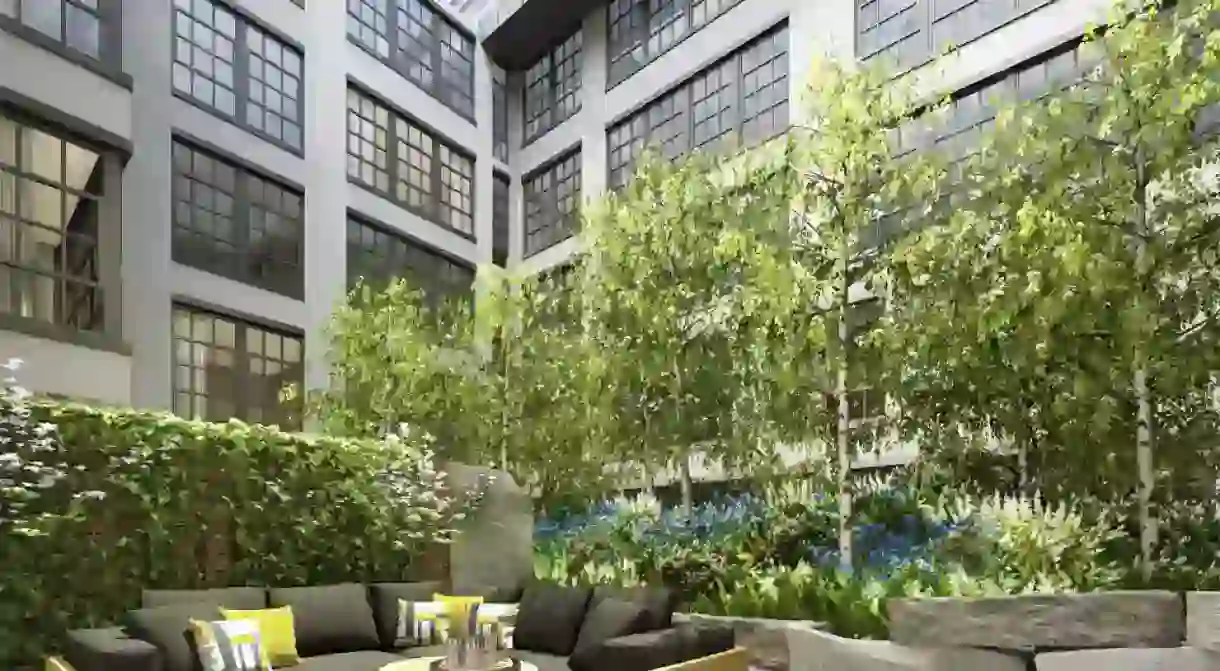NYC’s Most Lavish New 'Winter' Gardens

With the onset of fall comes the seasonal closure of some of our favorite outdoor havens. For city-dwellers, the constant concrete and hibernation can take its toll, which makes winter-friendly gardens a welcomed reprieve. As we transition into winter, we find ourselves stuck indoors way too often; not only separated from nature, but also from the health benefits of being outdoors. For New Yorkers in particular, winter can prove to be a harsh reality – but a few landscape architects are finding new ways to assuage the stark winter shut-ins with stunning new all-season gardens.
These landscape architects recognize the need for transitional outdoor spaces in new residential buildings in Manhattan, Brooklyn, and Queens; gardens that stay open during the large gap of time between Labor and Memorial Day. Some are re-calibrating their existing gardens (normally rooftop) to accommodate the flux of seasons and aim to better incorporate fall and winter landscapes.

Gramercy Square, a luxury condo project in Manhattan, is comprised of four ‘architecturally distinct buildings,’ connected by expansive green spaces. But they’re not your average green spaces reserved only for the summer season: landscape architect Rick Parisi of M. Paul Friedberg & Partners employed several techniques to make the gardens ‘winter friendly.’ He planted flowers and shrubbery that not only bloom at different times of the year, but also evoke a distinct autumnal hue during the seasonal transition.
“At a condominium like Gramercy Square where green spaces are central to the essence of the project and the courtyard is the visual focal point uniting the four buildings, it was critical to conceive a landscape that would evolve seasonally. By varying the plantings to include spring, summer and fall blooms, while also including species with an array of color transitions in fall, and others whose beautiful textures come through in winter, all are illuminated to stunning effect by indirect up lighting, we were able to create this dynamic, living work of art for residents to enjoy in a new way with each season,” Principal-in-Charge, Rick Parisi told The Culture Trip.
Texture also played a large part of the gardens’ design; Parisi selected trees with distinct texture and exfoliating bark to ensure they ‘stand out in the winter,’ and included both birch and ornamental trees. So rather than walking out into a plantless garden in the cold winter months, one can experience an emergence of new foliage.

51 Jay St., a warehouse conversion in Dumbo, Brooklyn, is another urban development that boasts conscious garden-design. Landscape architect Steven Yavanian considered the ebb and flow of seasons when he designed interconnected outdoor spaces for the warehouse-turned-condominiums.
“The Courtyard at 51 Jay Street is conceived as an immersive and layered landscape of trees, shrubs and perennials that showcases the natural beauty of New York’s four seasons. Through a combination of varied evergreen and deciduous leaf textures, successional flower blooms from early spring through late summer, striking fall foliage, and bright red berries contrasted against the white bark of birch trees in winter, the planting palette is as ever-changing and dynamic as the wild landscape that served as its inspiration,” Yavanian told The Culture Trip.

Over in Queens, The Grand at Sky View Parc is another residential development with a stunning garden: it’s actually a seven-acre rooftop park that includes evergreen trees, crape myrtle, and vibrant natchez trees. Landscape architect James P. Gilday of Moss Gilday Group says that it was important to “select and position plants that provide seasonal interest throughout the year, especially in the fall, winter and spring when many landscapes feel gray. The plant palette includes a mix of deciduous and evergreen trees, shrubs, groundcovers and perennials.” Consciously and strategically using a variety of color was of utmost importance during the design process: “Plants such as Witchhazels provide a wide range of red, orange and yellow leaf colors in fall, and beautiful threadlike flowers in late winter. The plants are also meticulously located to use sunlight and shadows in a way that highlights the seasonal transitions,” Gilday told The Culture Trip.

Studies have shown that prolonged exposure to nature has several health benefits, including mental clarity, improved attention spans, boosts in serotonin (the feel-good neurotransmitter), and even better eyesight (artificial light can lead to nearsightedness). So it’s a good thing that developers are considering more expansive ‘green spaces’ in their projects, if only to get New Yorkers outside more often.

Perhaps in the near future we’ll see more winter-friendly (transitional) gardens pop up in urban public spaces. We can hope.













